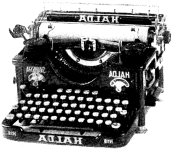A word has “vertical symmetry” when you can draw a vertical line in the middle and it’s the same on both sides — this is not quite the same as a palindrome, because it’s not just the same letters; it has to be visual symmetry. For that reason it matters whether the word is all upper case — and if you want to be especially particular, it depends on the typeface too. For example, “OTTO” has vertical symmetry, but “Otto” does not, even though both are palindromes. The longest words with vertical symmetry are no more than four letters: OTTO, MAAM, and TOOT.
Horizontal symmetry is the same thing, but you draw the line horizontally through the middle of each letter. This symmetry depends on capitalization too. You get some much longer words with horizontal symmetry: “BEDECKED” and “OKEECHOBEE” for example.
There’s one word, “Bid”, that has horizontal symmetry when it’s “BID”, and vertical symmetry as “bid”.
Then there’s rotational symmetry: if you put a pin in the exact center of the word and spin it halfway around, it stays the same. “SWIMS” works this way. “ONIONS” doesn’t have 180° rotational symmetry as a whole word, but each letter by itself does.
There are two 12-letter words that can be written using only the first half of the alphabet: “fickleheaded” and “fiddledeedee”. You can find both of these in the dictionary. That isn’t the case for the 1-letter-longer “cabbageheaded,” so that one doesn’t count. If you try this “half of the alphabet” thing you’ll notice that there are more vowels in the first half of the alphabet; there are only two in the second half. That’s probably why it’s harder to find words that include just letters from the latter part. “Nonsupports” is the longest at 11 letters. There are a couple of weird place names that qualify, but they’re simply in places where names seem strange to us; “Tuttoqquortooq” is in Greenland, for example. It kind of seems like cheating to allow things like that though.
Another foolish little word oddity is the puzzle that used to have an answer, but doesn’t any more. The puzzle is: “There are three English words ending in ‘-gry.’ The first two are ‘angry’ and ‘hungry’. What’s the third?”
When this puzzle was created, it probably wasn’t even true that there were “three” English words ending in ‘gry’ — there used to be more of them. But nowadays, other than “angry” and “hungry”, they’re all obsolete, so the puzzle doesn’t really have an answer. Unless of course you allow obsolete words like “meagry” or “aggry”. “Meagry” used to mean “meager”, and “aggry” is a kind of glass bead that was made in ancient times.
That hasn’t stopped people from turning the puzzle into a riddle, though, and there are lots of version of it. One is “There are three English words that end with the letters g, r, y. The first two are ‘angry’ and ‘hungry’; what’s the third?” The trick here is that the ORDER of the letters isn’t specified, so the answer is “energy”.
Another version of the riddle relies on nitpicky wording: “There are three words in English that end in “-gry”. Two words that end in “-gry” are “hungry” and “angry”. Everyone knows what the third word means. What are the three words that solve this riddle?” The answer to this version is “I am hungry” — that’s “three words in English;” the riddle didn’t say each word had to end that way. But really that’s one of those riddles that’s more annoying than amusing.
There are plenty more dumb little things about words, but I’ll end with one that sort of describes a reasonable reaction to this entire entry. The record for the most consecutive consonants in a word is seven. And the shortest word (that appears in a dictionary) with seven consecutive consonants is also seven letters long: “tsktsks.”
